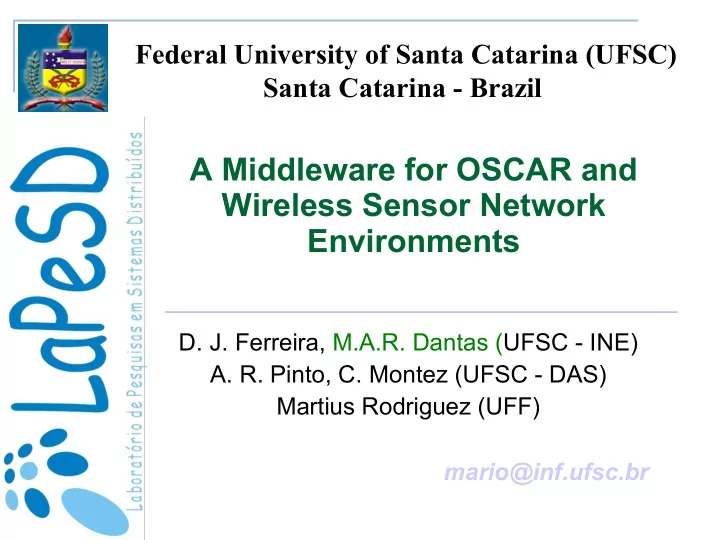

Federal University of Santa Catarina (UFSC) Santa Catarina - Brazil A Middleware for OSCAR and Wireless Sensor Network Environments D. J. Ferreira, M.A.R. Dantas (UFSC - INE) A. R. Pinto, C. Montez (UFSC - DAS) Martius Rodriguez (UFF) mario@inf.ufsc.br
Summary Introduction and Motivation Introduction and Motivation Sensor Networks and Cluster Sensor Networks and Cluster Computing Computing Proposed Approach Proposed Approach Experiments Conclusion and Future Works 2
Summary Introduction and Motivation Introduction and Motivation Sensor Networks and Cluster Sensor Networks and Cluster Computing Computing Proposed Approach Proposed Approach Experiments Conclusion and Future Works 3
Introduction Network Computing Pervasive Computing Anubis Graciela de Moraes Rossetto Alexandre Parra Carneiro da Silva 4
Introduction Network Computing Pervasive Computing HETEROGENEITY PDAs + clusters + desktops + high performance stations +sensors + cell phones ... Anubis Graciela de Moraes Rossetto Alexandre Parra Carneiro da Silva 5
Introduction Network Computing Pervasive Computing MOBILITY Logical and physical Anubis Graciela de Moraes Rossetto Alexandre Parra Carneiro da Silva 6
Introduction Network Computing Pervasive Computing HIGH DISPONIBILITY OF SERVICES AND DATA No matter dispositive, place or time Anubis Graciela de Moraes Rossetto Alexandre Parra Carneiro da Silva 7
Introduction Network Computing Pervasive Computing RESOURCE STATE ADAPTATION Anubis Graciela de Moraes Rossetto Alexandre Parra Carneiro da Silva 8
Introduction Monitoring Issues: High data stream; Generates large amount of information; Answer application tasks Anubis Graciela de Moraes Rossetto Alexandre Parra Carneiro da Silva 9
Introduction Available facilities from OSCAR software environment, represents an interesting option to manage clusters of workstations. The use of wireless sensor networks has a steady increase in number of configurations and kind of utilizations. 10
Motivation Design and implement a middleware prototype, which could creates for a sensor network an extra facility to process tasks inside a OSCAR cluster configuration. 11
Summary Introduction and Motivation Introduction and Motivation Sensor Networks and Cluster Sensor Networks and Cluster Computing Computing Proposed Approach Proposed Approach Experiments Conclusion and Future Works 12
Wireless Networks Provides: Software mobility; Faster communication; Low structure cost Challenges: Bandwidth; limited resources; frequent disconnections Anubis Graciela de Moraes Rossetto Alexandre Parra Carneiro da Silva 13
Wireless Sensor Networks Collect data from the environment; Brings new paradigms to applications; High deployed; Energy constricts; High information stream; Frequently disconnections. Communication routing; Data fusion. Anubis Graciela de Moraes Rossetto Alexandre Parra Carneiro da Silva 14
Wireless Sensor Networks sensor nodes characteristics: Low capacity of processor, communication and battery; Functions: sensor or routing; Can have a level of intelligence; 1 J to transmit 1 bit 0.5 J to receive 1 bit 0.8 J to 208 CPU cycles Anubis Graciela de Moraes Rossetto Alexandre Parra Carneiro da Silva 15
OSCAR Cluster Computing Manages globally and transparently cluster resources Provide some level of security, availability and tools to easy management of the environment. OSCAR consists of a fully integrated and easy to install software bundle designed for high performance computing cluster. Anubis Graciela de Moraes Rossetto Alexandre Parra Carneiro da Silva 16
Summary Introduction and Motivation Introduction and Motivation Sensor Networks and Cluster Sensor Networks and Cluster Computing Computing Proposed Approach Proposed Approach Experiments Conclusion and Future Works 17
Proposed Approach Why integrate wireless sensor networks and Clusters? Sensors are densely deployed on environments; There is a high information stream; Avoid overload the system with so much data; Store large amount of data; Provides remote access OSCAR: a solution to cluster management Anubis Graciela de Moraes Rossetto Alexandre Parra Carneiro da Silva 18
Proposed Approach Anubis Graciela de Moraes Rossetto Alexandre Parra Carneiro da Silva 19
Environment Configuration TinyOS: operating system for wireless sensor networks; Event driven; handles power consumption, radio communication Anubis Graciela de Moraes Rossetto Alexandre Parra Carneiro da Silva 20
Environment Configuration Anubis Graciela de Moraes Rossetto Alexandre Parra Carneiro da Silva 21
Proposed Approach Class Diagram 22
Proposed Approach Sequence Diagram 23
The Middleware Anubis Graciela de Moraes Rossetto Alexandre Parra Carneiro da Silva 24
Summary Introduction and Motivation Introduction and Motivation Sensor Networks and Cluster Sensor Networks and Cluster Computing Computing Proposed Approach Proposed Approach Experiments Conclusion and Future Works 25
Experiments 26
Experiments 27
Experiments 28
Experiments Anubis Graciela de Moraes Rossetto Alexandre Parra Carneiro da Silva 29
Experiments 30
Summary Introduction and Motivation Introduction and Motivation Sensor Networks and Cluster Sensor Networks and Cluster Computing Computing Proposed Approach Proposed Approach Experiments Conclusion and Future Works 31
Conclusion and Future Work In this article we have presented a middleware that was designed and implemented to improve the processing characteristic of a wireless sensor network through the use of the OSCAR software environment. 32
Conclusion and Future Work Our prototype considered: - a number of motes to sensor a field in a real time; - data are sent to a base station that will send the data to a OSCAR Cluster; - after a processing time the middleware notifies online a mobile device. 33
Conclusion and Future Work Challenges to be solved as a near future are: - Test the implementation for some routing topologies of sensors; - Enhance the alerts for different kinds of mobile devices; - Make available the final version of the middleware for the Oscar Group. 34
Questions? Questions? Mario Dantas Mario Dantas Federal University of Santa Catarina (UFSC) Federal University of Santa Catarina (UFSC) Department of Informatics and Statistics Department of Informatics and Statistics mario@inf.ufsc.br mario@inf.ufsc.br 35
Recommend
More recommend